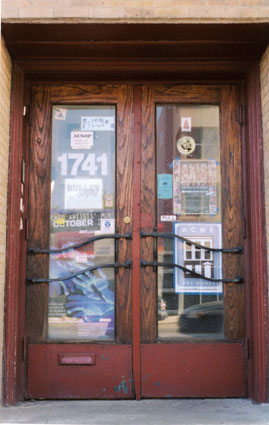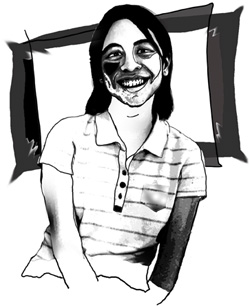So where do Chicagoans who can’t pay $850 a credit hour go to learn how to paint and draw? Where should graduates go to brush up on casting techniques they’ve sort of forgotten in the meantime? Or where can I go to learn how to throw a pot?
By Robyn Coffey
Chicago is home to a number of prestigious alternative art schools. Many are not-for-profit organizations that offer classes and memberships for participants, and a surprising number of the faculty and students of these establishments come from SAIC.
The Palette and Chisel Art Academy, housed in a beautiful turn-of-the-century mansion at 1012 N. Dearborn (www.paletteandchisel.org), is the oldest of these, founded in 1895 by night students at the Art Institute who wanted to paint life models in daylight. Today, the number of participating members is more than 200 nationwide, and prospective members must seek sponsorship from current ones.
The organization offers classes in anatomy for the artist, life drawing, oil painting, watercolor, and sculpture, plus painting and drawing for children and teenagers. Members receive a discount on classes and, like many non-profit art schools, are eligible to exhibit in the space’s gallery. Executive Director William J. Ewers says the painting classes are the most popular and that the students of the academy “range from the inexperienced hobby painter to the professional working artist. The majority of our students and members are people who attended art school and ended up working in graphic design or a similar art-related field.”
He explains that many working artists, including faculty, are involved with the school, and the small class size and highly skilled instructors enrich the educational experience. “Our fundamentals class is taught by two instructors who have developed their program over the last 23 years,” says Ewers. “Many of our instructors were mentored by the nationally renowned artist, Richard Schmid, and are quite adept at passing down his teachings.”
The Palette and Chisel’s mission statement declares that its goal is “to foster growth in the visual arts, provide a place for serious artists to work, and enrich the community with programs of art education, appreciation and exhibitions.” Many consider the Palette and Chisel to have an advantage over traditional art schools, which, as products of their time, move more and more toward graphic design and computer-related technology. On the other hand, the P & C maintains a steadfast dedication to good old-fashioned fine arts and continues to attract faculty and students on this basis.
Not to say the academy is unaware of current conditions facing artists just breaking into the scene; portraiture instructor Scott Tallman teaches students how to acquire commissions, the art of dealing with difficult personalities, and how to get paid. But perhaps the biggest draw to the P & C is the daily open studio workshops for figure drawing. These non-instructed sessions are free for members and $10 for the general public.
For those who live outside the Chicago metro area, there is the Suburban Fine Arts Center (SFAC) at 1957 Sheridan Road in downtown Highland Park (www.sfac.net). Located in a carefully renovated 14,000-square-foot American Legion hall, SFAC offers a huge variety of fine arts and arts and crafts classes for all ages, including drawing, painting, sculpture, photography, ceramics, mosaics, knitting, enameling, jewelry-making, digital art, stained glass, silk painting, brush painting, and storytelling.
“Our classes are small, so there’s lots of individual attention,” says Judy Fenton, director of communications and education. “We offer a variety of teachers who don’t conform to a rigid curriculum.”
Fenton says this enables SFAC to offer a more organic and personal artistic education, as opposed to a traditional art school where college-age students must complete a certain number of credits in a certain number of subjects in a certain amount of time. Fenton believes the variety of people who take classes at SFAC enable them to “feed off the energy and creativity of all ages and abilities, and [for young artists] to be able to see what’s possible if you continue.” She says the students, who number close to 700 each quarter, range in age from three to “close to ninety.” In addition, SFAC sponsors a slide registry, in which student work is exhibited in venues in Highland Park and Deerfield, including Starbucks coffee shops, public libraries, and a restaurant called Mimosa.
For hungry artists looking for more specialized instruction, there are several organizations that provide specific forms of knowledge. The Fire Arts Center at 1800 W. Cuyler (www.firearts.org) is a very highly regarded metal and classical sculpture facility. It offers the only fully equipped, teaching foundry in the city besides the Art Institute, with capabilities for large-scale casting, forging, welding, kiln-firing and furnaces. According to Bryce Reynier, president of the board of directors, the classes that fill up most quickly are Foundry, Metal Furniture Design, and Figure Sculpture, which their website describes as “essential to the understanding of the complexity of the 3-dimensional form, as drawing is to the understanding of color, light, and composition.”
The Fire Arts Center is an excellent example of the difference between alternative art classes and traditional fine art schools. “We’re thought of as scrappy and dynamic in comparison to larger organizations,” explains Reynier. “We emphasize technique and craft over theory. ûWe’re very hands-on and live by the mantra, ‘Shut up and work.'”
Similarly, the Lillstreet Art Center at 4401 N. Ravenswood (www.lillstreet.com), has the same emphasis on down-to-earth technique, but also underscores the importance of a conceptual, theoretical basis for artmaking. Founded in 1975, Lillstreet, which is the largest ceramics facility in the Midwest, moved last year from a converted horse barn to a former gears factory, and is furnished with state-of-the-art equipment for clay and ceramics, as well as jewelry, painting, drawing, and fibers.
“Our classes are very skill-based, so students can expect to hone techniques important in the development of a solid practice in object-making,” says Shannon Stratton, communications director. Stratton describes the curriculum as ideal for those wishing to undertake a visual arts education who don’t have the time or money to enroll in a degree program. Most classes are taught by professional artists, many of whom have studied or currently teach at SAIC.
Stratton says the programs at Lillstreet are useful for “those graduates looking for continued education in specialized techniques, and the facilities necessary to develop them. It is an open, community-style school that allows students to come and go over a long period of time — students have started at Lillstreet as children and continued on as adults.”
All of the organizations mentioned here are non-profits who survive on the dues and tuition paid by members, who are in turn provided with discounts for classes and access to galleries and equipment. Memberships generally run anywhere between $40 a year to more than $500, often with deductions or special rates for seniors and families.
So once you graduate from the Art Institute and feel like you need to refresh your skills or (more likely) when you are forced to drop out due to rising tuition costs, consider a membership in an arts organization. You’ll still be surrounded by talented working artists and high-quality facilities, but you’ll probably save a bundle and maybe even have a better chance at getting your work shown.
Related links:
www.paletteandchisel.org
www.sfac.net
www.firearts.org/
www.lillstreet.com







